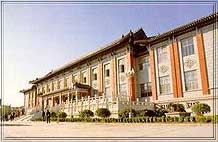 |
The Museum of Jingzhou Prefecture in Hubei, founded in 1958, is a local historical museum of China. Situated in Jingzhou County of Hubei Province, the Museum covers an area of 46,600 square meters.
The Museum boasts a collection of over 100,000 relics, more than 200 of which have been listed as national first-grade cultural relics. The most typical items of the Museum are ancient bamboo slips, lacquer wares and silk.
There basic display is about the historical relics in Jingzhou area, centering on the 6,000-year Chu (ancient name for Hubei region during the Han Dynasty) Culture, spanning from the Neolithic Age to Western Han Dynasty (206BC-8AD). Exhibits of the Neolithic Age include Daxi Culture, Qujialing Culture and Hubei Longshan Culture. According to documents, this area used to be the capital of the Chu State for about 411 years, leaving behind abundant Chu cultural relics.
Exhibits of the Chu Culture mainly include bronze wares, weapons, lacquer wares and musical instruments. In particular, an important collection of lacquer ware, 2,000-year-old silk garments and fabrics featured with exquisite patterns and an almost perfectly preserved male corpse of a Han-Dynasty official, are on display.